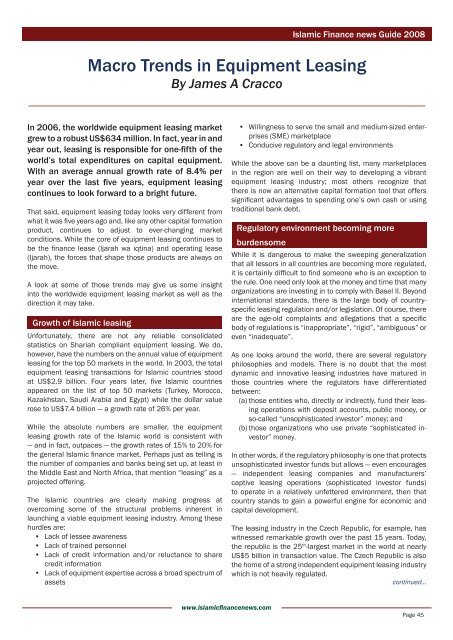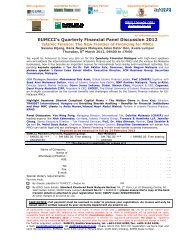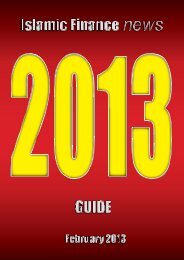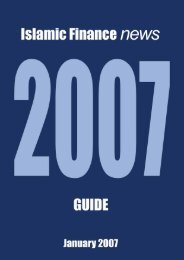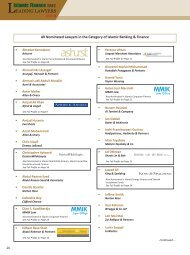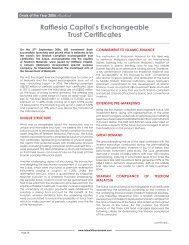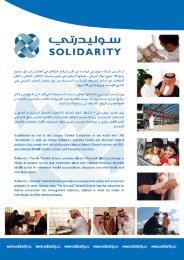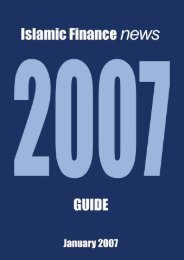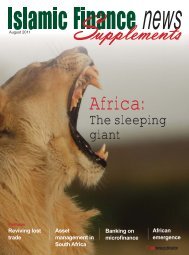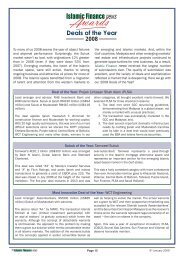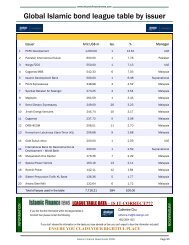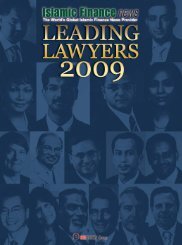You also want an ePaper? Increase the reach of your titles
YUMPU automatically turns print PDFs into web optimized ePapers that Google loves.
www.islamicfi nancenews.com<br />
<strong>Islamic</strong> <strong>Finance</strong> news Guide 2008<br />
Macro Trends in Equipment Leasing<br />
By James A Cracco<br />
In 2006, the worldwide equipment leasing market<br />
grew to a robust US$634 million. In fact, year in and<br />
year out, leasing is responsible for one-fi fth of the<br />
world’s total expenditures on capital equipment.<br />
With an average annual growth rate of 8.4% per<br />
year over the last fi ve years, equipment leasing<br />
continues to look forward to a bright future.<br />
That said, equipment leasing today looks very different from<br />
what it was fi ve years ago and, like any other capital formation<br />
product, continues to adjust to ever-changing market<br />
conditions. While the core of equipment leasing continues to<br />
be the fi nance lease (Ijarah wa iqtina) and operating lease<br />
(Ijarah), the forces that shape those products are always on<br />
the move.<br />
A look at some of those trends may give us some insight<br />
into the worldwide equipment leasing market as well as the<br />
direction it may take.<br />
Growth of <strong>Islamic</strong> leasing<br />
Unfortunately, there are not any reliable consolidated<br />
statistics on Shariah compliant equipment leasing. We do,<br />
however, have the numbers on the annual value of equipment<br />
leasing for the top 50 markets in the world. In 2003, the total<br />
equipment leasing transactions for <strong>Islamic</strong> countries stood<br />
at US$2.9 billion. Four years later, fi ve <strong>Islamic</strong> countries<br />
appeared on the list of top 50 markets (Turkey, Morocco,<br />
Kazakhstan, Saudi Arabia and Egypt) while the dollar value<br />
rose to US$7.4 billion — a growth rate of 26% per year.<br />
While the absolute numbers are smaller, the equipment<br />
leasing growth rate of the <strong>Islamic</strong> world is consistent with<br />
— and in fact, outpaces — the growth rates of 15% to 20% for<br />
the general <strong>Islamic</strong> fi nance market. Perhaps just as telling is<br />
the number of companies and banks being set up, at least in<br />
the Middle East and North Africa, that mention “leasing” as a<br />
projected offering.<br />
The <strong>Islamic</strong> countries are clearly making progress at<br />
overcoming some of the structural problems inherent in<br />
launching a viable equipment leasing industry. Among these<br />
hurdles are:<br />
• Lack of lessee awareness<br />
• Lack of trained personnel<br />
• Lack of credit information and/or reluctance to share<br />
credit information<br />
• Lack of equipment expertise across a broad spectrum of<br />
assets<br />
• Willingness to serve the small and medium-sized enterprises<br />
(SME) marketplace<br />
• Conducive regulatory and legal environments<br />
While the above can be a daunting list, many marketplaces<br />
in the region are well on their way to developing a vibrant<br />
equipment leasing industry; most others recognize that<br />
there is now an alternative capital formation tool that offers<br />
signifi cant advantages to spending one’s own cash or using<br />
traditional bank debt.<br />
Regulatory environment becoming more<br />
burdensome<br />
While it is dangerous to make the sweeping generalization<br />
that all lessors in all countries are becoming more regulated,<br />
it is certainly diffi cult to fi nd someone who is an exception to<br />
the rule. One need only look at the money and time that many<br />
organizations are investing in to comply with Basel II. Beyond<br />
international standards, there is the large body of countryspecifi<br />
c leasing regulation and/or legislation. Of course, there<br />
are the age-old complaints and allegations that a specifi c<br />
body of regulations is “inappropriate”, “rigid”, “ambiguous” or<br />
even “inadequate”.<br />
As one looks around the world, there are several regulatory<br />
philosophies and models. There is no doubt that the most<br />
dynamic and innovative leasing industries have matured in<br />
those countries where the regulators have differentiated<br />
between:<br />
(a) those entities who, directly or indirectly, fund their leasing<br />
operations with deposit accounts, public money, or<br />
so-called “unsophisticated investor” money; and<br />
(b) those organizations who use private “sophisticated investor”<br />
money.<br />
In other words, if the regulatory philosophy is one that protects<br />
unsophisticated investor funds but allows — even encourages<br />
— independent leasing companies and manufacturers’<br />
captive leasing operations (sophisticated investor funds)<br />
to operate in a relatively unfettered environment, then that<br />
country stands to gain a powerful engine for economic and<br />
capital development.<br />
The leasing industry in the Czech Republic, for example, has<br />
witnessed remarkable growth over the past 15 years. Today,<br />
the republic is the 25 th -largest market in the world at nearly<br />
US$5 billion in transaction value. The Czech Republic is also<br />
the home of a strong independent equipment leasing industry<br />
which is not heavily regulated.<br />
<strong>continued</strong>...<br />
Page 45


